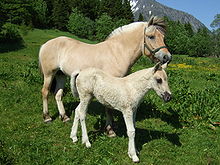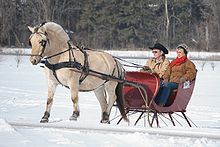Norwegian fjord horse
| Norwegian fjord horse | |
|---|---|

|
|
| Important data | |
| Origin: | Norway |
| Main breeding area: | Scandinavia |
| Distribution: | Norway, Germany, Denmark, Western Europe |
| Stick measure : | 135-150 cm |
| Colors : | Duns |
| Main application area: | Leisure riding, pack horse, draft horse |
The Norwegian Fjord Horse (also Norwegian , Fjordinger , Fjordpferd or Fjordpony ) is a horse breed that originates from the coastal areas of Norway .
Background information on horse evaluation and breeding can be found under: Exterior , interior and horse breeding .
Exterior
anatomy
The fjord horse is a typical strong, baroque type standing small horse (well over 120 cm). The fjord horse has characteristics of old horse breeds that are strongly reminiscent of Eastern European and Asian wild horses. It has a broad forehead with alert, calm and clear eyes. The large, straight head with its expressive eyes and small, pointed ears sits on a very strong neck. The nostrils are large. The strong horse has a strong, broad shoulder and chest, flat withers and an elastic, stable back. The chest is wide and deep, the croup sloping. The short legs are stable and muscular, sometimes equipped with zebra stripes and light drop traps. The height is 135 to 150 cm.
In the meantime, standing horses are mainly bred in the sporty type, here the legs are a little thinner and they are slimmer overall.
colour
Fjord horses come in all fawn colors, the mane is two-colored and usually cut so that it stands upright. The color of the dun is always accompanied by an eel line , and legs with zebra-like stripes can sometimes be seen. The fjord horses are usually pure-bred duns. The following fawns can be found in the fjord horses:
- Light falcons (ulsblakk)
- Braunfalben (brunblakk)
- Light brown falcons (lys brunblakk)
- Dark brown falcons (mørk brunblakk)
- Greyalves (grå)
- Red falcons (rødblakk)
- Yellow (gul)
- White falcons (ulsblakk)
The Cremellofalbe / Perlinofalbe / Smoky Cream Falbe (kvit) can occur, but is not desirable according to the breeding standard. The breeding standard also stipulates that white markings on the head or legs of the fjord horse are undesirable. Small badges are tolerated for mares, but not for stallions.
mane
Fjord horses naturally have a hanging mane, but this is often trimmed to a standing mane in riding horses. Cutting a horse's mane has been a tradition in Northern Europe since the Viking Age. For example, horses with the traditional stand-up mane typical of fjord horses are depicted on rune stones . With a correctly trimmed mane, the inner black mane hairs are slightly higher than the light side hairs. This way the eel line and the strong neck should be better expressed.
interior
The fjord horse, like most pony breeds , is considered robust, undemanding, balanced, docile and long-lived. It was Norway's all-round horse that was used for all kinds of work. The fjord horse was used as a riding and carriage horse and was harnessed to the plow in agriculture. They are also good for children, as fjord horses are very good natured. It was also used as a return horse . To this day, the climber, who is also excellent under heavy loads, is used as a pack horse by the Norwegian mountain troops .
Fjord horses are used by recreational riders today , they are suitable for trail rides , endurance riding, rallies and skill tournaments. They are also used as therapy horses. They are also good riding horses for children. In the meantime, the fjord horses are also rising in competition. You see them more and more often in dressage competitions up to class L and in jumping up to class A, where they also have some successes. Fjord horses are extremely successful in driving competitions. Team world champions and some national champions of pony team drivers use fjord horses.
Breeding history
The breed has ancient roots. Nevertheless, all today's representatives of the breed go back to a single stallion who was used for pure breeding for over 17 years at the turn of the 20th century. Fjord horses have been purebred since 1907. This means that no foreign races are used for refinement. At the world exhibition " Expo 86 " in Montreal Canada , the pony was Norway's trademark.
See also
Individual evidence
- ↑ Interest group Fjordpferd eV - Appearance ( Memento of the original from May 4, 2014 in the Internet Archive ) Info: The archive link was inserted automatically and has not yet been checked. Please check the original and archive link according to the instructions and then remove this notice.
- ↑ a b Bunzel-Drüke, Finck, Kämmer, Luick, Reisinger, Riecken, Riedl, Scharf & Zimball: "Wilde Weiden: Practical guidelines for year-round grazing in nature conservation and landscape development . Working group for biological environmental protection in the Soest district (ABU), Bad Sassendorf-Lohne, 2nd edition, 2009. ISBN 978-3-00-024385-1



